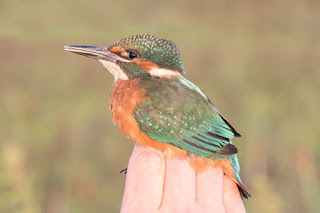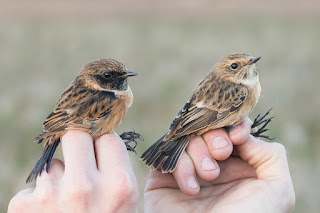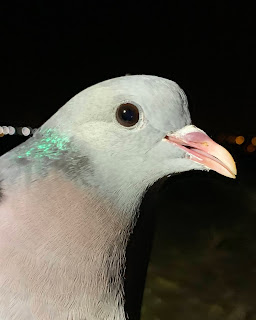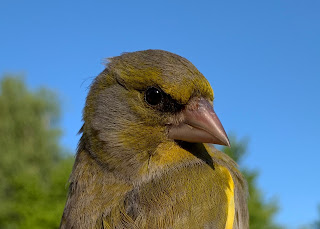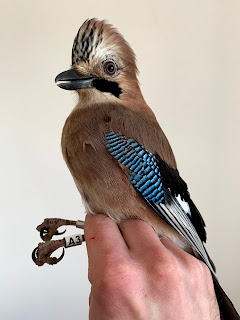In March 2019 two UEARG members (myself & Kirsty) moved into our new home, which fortunately for us backs onto Charter Wood. This 35-acre wood on the western outskirts of Norwich was planted in 1994, and is managed by the Norwich Fringe Project. The wood is flanked by horse pasture and a 50-acre arable field with corn grown last year and the field was left as a stubble through winter. The group have previously not ringed here, so we weren't sure what to expect. I’m lucky enough to be able to work at home with my computer-based PhD (even before Covid-19!) which has afforded me the opportunity to monitor the woodland pretty intensively over the past year. It's not a particularly busy ringing site, and this enables me to balance ringing with work (with some additional evening catch-up where needed).
Ringing effort was mainly in the garden and a single 18-metre mist net just the other side of our back fence leading into the woodland. Supplementary feeding was supplied year-round but was greatly reduced during summer. We also dabbled in a bit of dazzling in the stubble field in late-winter.
View from the ringing room overlooking Charter Wood.
Charter Wood and the garden by the numbers.
Despite the woods relatively young age we’ve been pretty surprised by not just the numbers, but the diversity of species ringed in the past year. For me this is a nice signpost that these relatively immature planted woodlands, especially when managed as Charter Wood is, can be a great ecological success. Here is a brief overview of totals, but at the end of this blog I’ll throw in a bunch of more detailed graphs of what we have found for those of us that enjoy a graph or two.
Between March 31st 2019 and March 31st 2020, we ringed a total of 1,568 birds across 27 species within Charter Wood and the garden. Unsurprisingly with feeder-based ringing, Tits dominated the catch with Blue and Great Tits making up 49% of the total birds ringed. However, we also had good returns of finch species, particularly Greenfinch with 167 ringed. Inevitably with feeder ringing, you also accumulate a lot of reencountered birds and with these subsequent encounters included it brought our total encounters for the year up to 3,509 and supplies us with great ongoing data on survival in the population. Despite this large number of reencounters, the majority of our birds are still yet to be subsequently encountered.
Table: Birds ringed in Charter wood 31/03/2019-30/03/2020.
Species
|
New
|
Retraps
|
Total
|
Blue Tit
|
468
|
795
|
1263
|
Great Tit
|
301
|
682
|
983
|
Greenfinch
|
167
|
23
|
190
|
Chaffinch
|
149
|
39
|
188
|
Blackbird
|
102
|
66
|
168
|
Goldfinch
|
87
|
18
|
105
|
Dunnock
|
57
|
82
|
139
|
Robin
|
54
|
100
|
154
|
Long-tailed Tit
|
42
|
95
|
137
|
Collared Dove
|
26
|
1
|
27
|
Jay
|
15
|
13
|
28
|
Woodpigeon
|
15
|
7
|
22
|
Chiffchaff
|
14
|
1
|
15
|
Blackcap
|
12
|
0
|
12
|
Coal Tit
|
11
|
9
|
20
|
Wren
|
10
|
2
|
12
|
Great Spotted Woodpecker
|
8
|
3
|
11
|
Goldcrest
|
8
|
0
|
8
|
Bullfinch
|
6
|
1
|
7
|
Brambling
|
4
|
1
|
5
|
Treecreeper
|
2
|
2
|
4
|
Reed Bunting
|
2
|
1
|
3
|
Song Thrush
|
2
|
0
|
2
|
Sparrowhawk
|
2
|
0
|
2
|
Magpie
|
2
|
0
|
2
|
Green Woodpecker
|
1
|
0
|
1
|
Starling
|
1
|
0
|
1
|
|
|
|
|
Total
|
1,567
|
1,941
|
3,508
|
Highlights:
- I estimated a loose winter flock of ~250 Greenfinch were present in the wood this year, an excellent number for this species that was so badly hit by trichomonas. This is potentially an underestimate, as catching two-thirds of the flock would be a pretty good rate.
- Chaffinch numbers would be higher, but the local population is suffering from papillomavirus and as such those birds are released unringed.
- A couple of Brambling were great additions during early winter and two more individuals were ringed during spring passage. I assumed the Autumn birds were just passage, but a retrap of the female 17 days later indicated she was perhaps just being inconspicuous.
- 26 Collared Doves ringed won’t excite many ringers, but by 2018 numbers this is 50% of the county total.
- 15 Jays ringed on the other hand did feel special for a single site in a short-ish period, so we started a colour ringing project on them in January 2020. We’ve only fitted 2 colour rings so far, but we are expecting/hoping captures will increase later in the season.
- No feeding station would be complete without a Sparrowhawk or two eking out a living. We’ve had at least two individuals this year, with both a male and female finding their way into a mist net. Sadly, the male was found dead after entering a man-made structure locally just 22 days later.
- Controls and recoveries have been pretty quiet for this site sadly. What movements we have had have only been local movements of Tits. We are still waiting to hear back about a Blue Tit ringed back in 2014 though, so hopefully that will be more exciting.
- 9 ringed birds have subsequently been found deceased, in all cases unrelated to the ringing event. 5 of these were a result of predation from domestic cats, a Sparrowhawk died after entering a man-made structure, and 3 birds succumbed to natural causes.
Heard often in Charter Wood but rarely ringed, just six Bullfinch over the year.
Heard even more than Bullfinches, but seldom caught. This adult female is one of at least five Green Woodpeckers in Charter Wood. You can see the sticky saliva in her bill that helps them catch ants and other invertebrates.
Charter Wood doesn't attract many Goldcrests, only 8 were ringed across the year.
One of the two Treecreepers ringed.
Plenty of Woodpigeons in Charter Wood, only a tiny proportion were ringed.
The very first bird ringed; a Great Tit sporting a completely white outer tail feather.
Dazzling
Bordering the northern edge of Charter Wood is a 50-acre arable field that was left as stubble this winter. Skylarks breed here on the neighbouring horse pasture so I suspected we may also have a wintering population that we could try and monitor. Being inside a city doesn’t really lend itself to dazzling (catching birds by torch and hand net), our light pollution to put it simply is pretty horrendous and for dazzling you want it dark. The saving grace was a thermal imager, lent to us by group leader Iain Barr. With the imager we can find birds more efficiently and ensure a better approach for catching; combining this with choosing the best conditions to reduce light pollution really helped our success rate. We didn’t have access to the imager for most of the winter but in February and March we had a chance to put some time into monitoring the birds using the stubble field during winter. It was also a great opportunity for me to teach a few group members that have not experienced much of the technique and I usually had a group with me in tow. To our surprise we stumbled across a particularly good population of Woodcock (in Norwich terms) with counts as high as 15 our best. We were delighted to ring 9 Woodcock, especially considering only 9 were ringed in the entirety of Norfolk in 2018! Counts of Skylark roosting in the field peaked at ~10-15 on a single night, with at least three singing males during the day that I can currently hear singing high above the house as I type. We managed to ring 15 Skylark, a species rarely caught by conventional methods which is reflected in the fact that only 2 adults were ringed in the whole of Norfolk in 2018. We also recorded several pairs of Red-Legged Partridge, as well as sparse encounters with Lapwing, Stock Dove, Little Owl, Redwing, and Fieldfare. This was only with a handful of visits though, so we are excited to get back out monitoring next winter.
Ringing totals:
Species
|
New
|
Retrap
|
Total
|
Skylark
|
15
|
2
|
17
|
Woodcock
|
9
|
3
|
12
|
Stock Dove
|
2
|
0
|
2
|
Lapwing
|
1
|
0
|
1
|
Redwing
|
1
|
0
|
1
|
Total
|
28
|
5
|
33
|
I had peak counts of 8 Stock Dove on the farm during the day mixed in with the more common Woodpigeons, but we didn't come across many roosting at night.
No day time records of Lapwing on the farm, so to record an individual present at night was a treat.
One of the many Woodcock using the farm to feed at night, and the view through the thermal imager as I approached it.
Charter Wood nest box scheme
As part of ongoing monitoring of the wood we embarked on establishing a nest box scheme in early 2020. With a grant from UEARG to supply the wood we built 56 hole-fronted nest boxes and 5 open-fronted nest boxes that have gone up throughout the wood. We have also put up raptor boxes with one of each Kestrel, Tawny Owl, and Little Owl box going up. With this and a large chunk of nest finding, we can now hopefully start monitoring the breeding success of some of the wood’s inhabitants. Unfortunately, a well-meaning member of the public has recently also put up roughly 20 boxes through the woodland (without permission) and these boxes are sealed shut so will not be able to be monitored.
One of the many passerine nest boxes.
Tawny Owl Nest Box. Both Male and Female calls have been heard in Charter Wood through early spring.
Graphs of Charter Wood ringing
Captures by month
Total monthly captures unsurprisingly peaked in late autumn/winter months, with the busiest month being October. Supplementary feeding was provided to a far greater extent in winter and winter is generally the time when bird numbers at the feeders peak.
Captures by month corrected
Correcting for the amount of trapping effort each month isn’t very easy when you operate varying trapping methods (some of which are passive such as maze traps). A very rough way of correcting for effort is to simply calculate number of birds caught per trapping day (where a trapping day is considered a day where at least one individual was trapped). Here we see peak captures occurring in November rather than October.
Species richness by month
The number of species caught each month was fairly stable but this month was our best with 21 different species ringed.
Top 6 species by month
Here is the monthly captures for the most frequently caught species, corrected by number of trapping days in that month.
Capture number histogram
Most birds (57%) have only ever been encountered once, but a small proportion can be described as ‘trap happy’ and end up making up a surprising proportion of our large number of retraps (just 26 individuals make up almost 20% retraps). These are mostly Great Tits, Dunnocks, and Robins that become accustomed to potter traps and perhaps considered the free meal a worthwhile trade for the data I wanted from them.
















